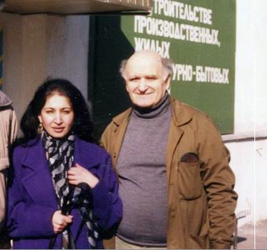звоните: +7 495 204-207-8
e-mail: art@quartagallery.ru
Recent posts
- Необычная судьба тверской художницы Наталии Пономаревой
- Жемчужина деревянной архитектуры русского севера
- Первая народная галерея в Льялово
- Online auction - a practical instruction. How to take part?
- История русской анимации и коллекционирование «истории» мультипликационных фильмов
- История в гравюрах и литографиях уникального печатного издания «Революционная Москва: Третьему конгрессу Коммунистического Интернационала». 1921
- Painting as a Gift
- What happened to frescoes of Kievskaya Metro Station?
Nina Gabrielyan — a Poet, a Novelist, an Artist
A fragment from the article by the artist Yury Alexandrov about the creative activity of Nina Gabrielyan. 2007. Translation by Evrika Allaverdonts
Not once have I looked at these long rows of her first watercolors and gouaches. Not once have I looked at these long rows of her first watercolors and gouaches. They stunned me with the abundance of varying in every possible way, repeated closed shapes, inside of which there moved and crouched and lived their oppressed, constrained way of life, some figures placed there, often in twos, more seldom in a bunch. It looked as though somewhere in a cave, in a crypt or a catacomb or maybe in some chimeric wombs, there were born and lingered some strange lifeform with its incomprehensible goals, probably getting ready to come out into the big world, but suppressed by external forces it could not ooze out, so it had to save its strength while waiting in the wings.
Despite the symbolism of these images the author is reluctant to explain her hunch, insisting that most frequently “they were born on their own" and even against her will to do something different. A certain degree of sameness in her motifs and their repeating color patterns underwent changes over time, as though those embryonic forms of proto-creatures gradually acquired new senses and new abilities, and the “wombs", those black-and-red and purple-and-grey crypts, could no longer keep the developing shapes inside them and were on the verge of opening up and letting go of the born organisms, which exactly what happened later on.
With the artist mastering her material, her techniques also changed and the range of colors she used broadened. Nina began to use acryl and further on oil sprang up as the most universal technique. Her coloristic solutions also expanded. The color became richer and more exquisite, however her favorite color scale is closer to the red-and-purple and brown-and-ochre part of the spectrum, which sometimes includes slightly complicated dark-blue tint turning into black in deep zones of shades and contours. The compositions opened up and Nina Gabrielyan's lifeforms came out having acquired the ability for self-standing.
Her world is uncomfortable for the eye accustomed to the developed European school of painting. There is no unifying and harmonizing art environment which cheers you up so much in the impressionists' canvases. Gabrielyan's world breathes out the severe, almost menacing, beauty of towering rocks and biblical deserts where you can wander endlessly in search of oases, where settled lifestyle is possible with its old-fashioned routines and quite life's joys, but it is unlikely to be found. It seems that God has just created this land and let people live and settle there but, dumbfounded by this new reality, they still have to get used to it. It might be the reason why her characters usually have their eyes wide open watching something in front of them with almost insane astonishment.
At the same time the artworks of Nina Gabrielyan clearly have been influenced by the European art culture, and they prove her to be highly knowledgeable in this area. This combination of archaically primitive forms and exquisiteness is one of the main features of her artworks, which makes her creativity akin to the expressionists of the beginning of the 20 th century and adds special spiciness to her paintings. If we look at her artworks in terms of continuity and “culture dialog" then Nina's art will be a bright example of such dialog and such continuity. Nina's art preferences vary greatly from ancient Armenian artists (Toros Roslin, unnamed sculptors and carvers and others) to our contemporaries from Asia and Europe. Among Armenian painters she highly values Martiros Saryan, Robert Kondakhsazov, Minas Avetisyan, Sergey Parajanov and especially Boris Otarov. 


In the artist's paintings you can notice not only the influence of the aforesaid masters. Sometimes her clean-cut, generalized to the extent of monumentality, shapes of her characters bring on associations with the images of Pirosmanishvili or Henri Rousseau. It is no coincidence that collectors of so-called “primitivists" or, as they say nowadays, “original" masters are interested in her artworks. Nevertheless, do not get confused there. Intellectual fullness of her paintings excludes the possible inner relation to primitivism. Nina has never worked on the edge of naïve spontaneity which is so typical of the artists working in this genre. Archaically generalized interpretation of forms in her artworks is a consciously employed method helping her to convey the meaning inherent in her paintings. It should be noticed that in the 20 th century some very famous masters of European art turned to the primitivists' experience: Picasso, Chagall, Leger…
The creativity of Nina Gabrielyan is always on the lookout for new ways and forms of expression in all genres and styles of art she is involved in, whether it is literature, translation, art criticism, painting. For the last few years the coloristic solutions of her paintings have become more and more exquisite and complex, her compositions have complicated and new storylines have arisen.
